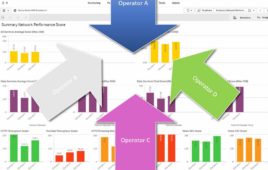Sprint today reported shrinking first-quarter losses of $643 million, down from $863 million in the same period last year. Revenues from the Sprint platform were up 9 percent annually to $7.1 billion.
CEO Dan Hesse said in an earnings call that Sprint is on track to shut down its iDEN network by the end of the second quarter. The company said postpaid subscriber growth on the Sprint platform continued to benefit from better than expected recapture rates of Nextel customers.
Still, subscriber numbers suffered in the quarter. Including those customers who have left the Nextel brand, Sprint racked up 560,000 customer losses. That compare to Verizon Wireless, which added 677,000 subscribers in the quarter, and AT&T which added 296,000 subscribers.
The Sprint platform saw postpaid Average Revenue Per User (ARPU) of $63.57, up from $62.55 in the same quarter last year.
Sprint customers followed the industry trend of migrating to smartphones. The company reported that 86 percent of quarterly Sprint platform postpaid handset sales were smartphones, including more than 1.5 million iPhones sold during the quarter. Forty-three percent of iPhone sales were to new customers.
While Hesse said that Sprint has seen a slight impact in iPhone sales from T-Mobile now offering the device, the company hopes that’s temporary and said the effects won’t be known until next quarter.
“The iPhone, with respect to T-Mobile having it, is really more of 2Q phenomenon…We’ll monitor that very, very closely,” Hesse said. “There’s always a temporary impact when a device as iconic as the iPhone is picked up by another carrier.”
Hesse said that upgrades continued to be a challenge, as they bring with them the burden of high subsidies. Sprint will see more upgrades in the coming quarter as high-profile devices like the HTC One, Samsung Galaxy 4 and perhaps an iPhone refresh, hit stores. Hesse stressed the importance of upgrade policies but added that his company would probably not play its 20-month cycle against Verizon’s new 24-month cycle in its marketing.
“We’re not seeing any evidence that customers are looking to upgrade any less often…in fact the opposite might be true, which means these upgrade policies are really important,” Hesse said.
Overall the company’s Network Vision modernization plan appears to be on track. To date there are more than 13,500 sites on air compared to more than 8,000 reported on Feb. 7. The number of sites that are either ready for construction, already underway or completed has grown to more than 25,000.
Hesse said Sprint is on track to shut down its iDen network by the end of the second quarter. The company said postpaid subscriber growth on the Sprint platform continued to benefit from better than expected recapture rates of Nextel customers.
Meanwhile, Sprint has launched 4G LTE in 88 cities, including Los Angeles, Boston and Charlotte, N.C. since the beginning of the year and expects that 4G LTE will be available in more than 170 additional cities in the coming months.
On guidance, Sprint raised its numbers for the year, but added that those numbers do not take into account an acquisition by either Dish Network or Softbank, both of which have bid pending with Sprint. Sprint now expects 2013 adjusted operating income before depreciation and amortization to hit $5.5 billion, the higher end of its previous range.
Sprint is in the process of considering an offer to acquire from Dish Network valued at $25.5 billion, while also taking into account an offer from Japanese carrier Softbank to acquire 70 percent of Sprint for $20.1 billion.
Shares of Sprint remained relatively flat in early trading at $7.09.




